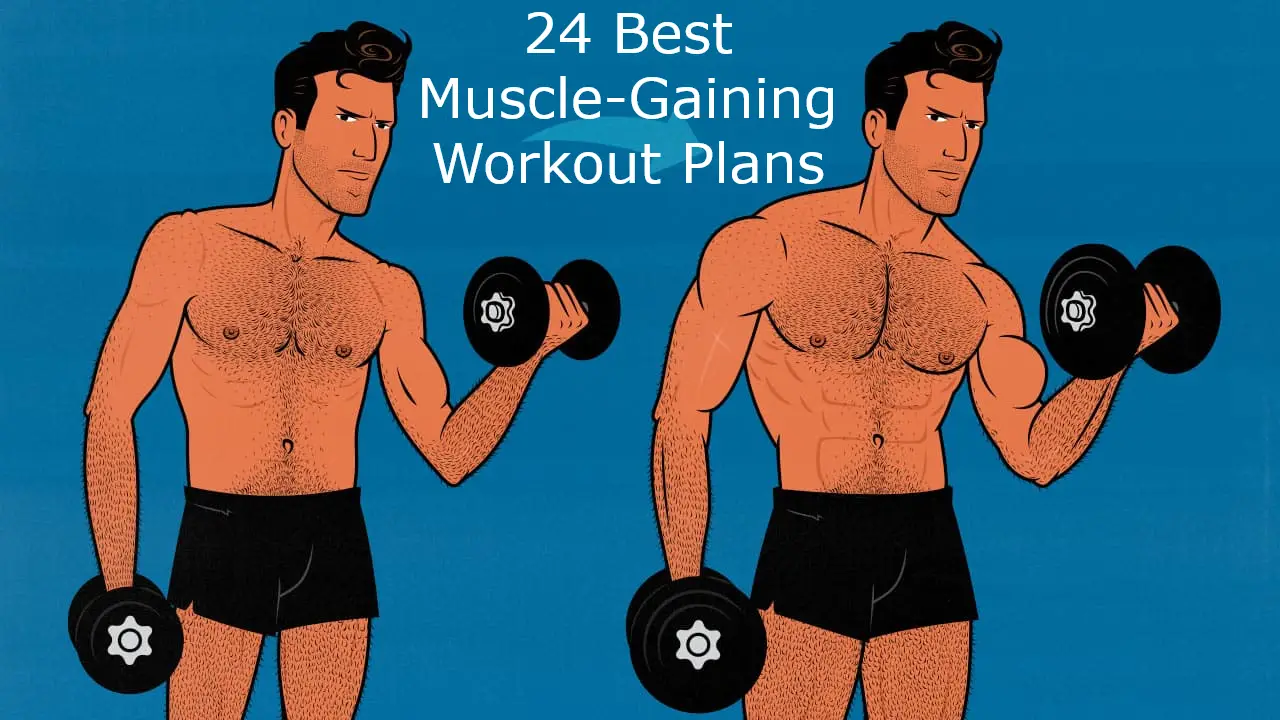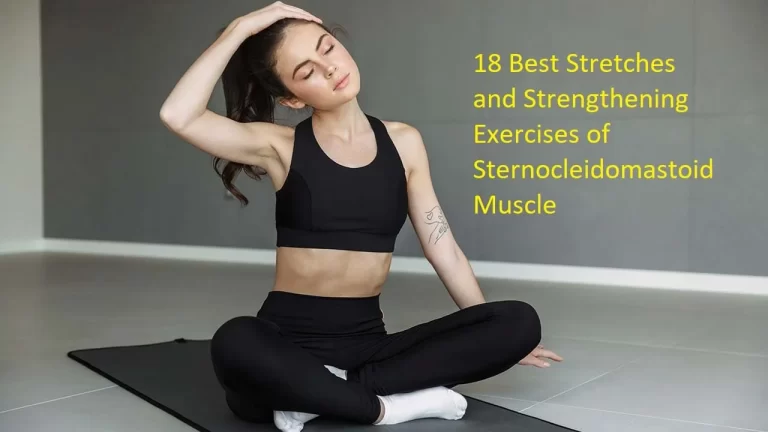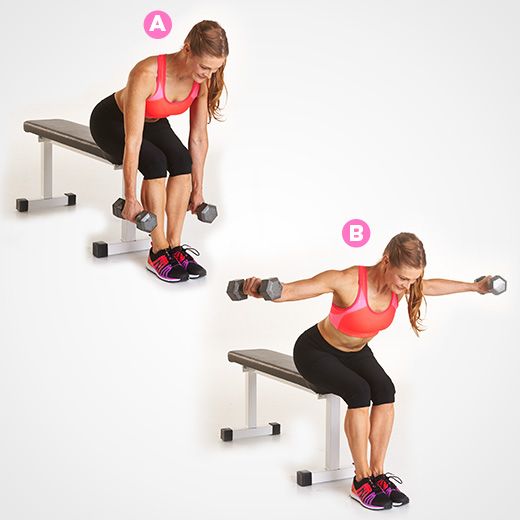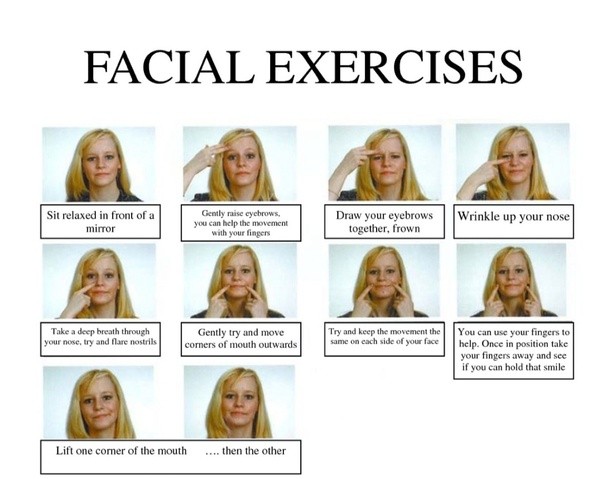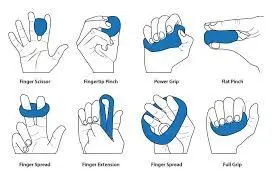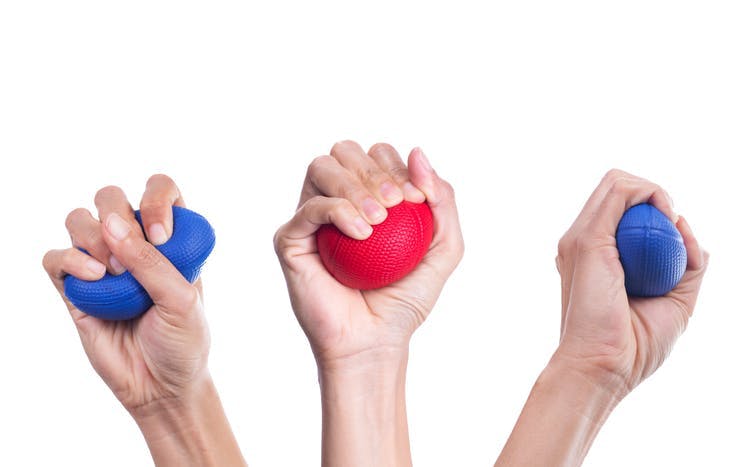24 Best Muscle-Gaining Workout Plans
The Best Workout Plan For Gaining Muscle
Do you wish to strengthen those muscles, then? That’s fantastic! Unfortunately, there are no shortcuts when it comes to building muscle; consistent strength training must be done for an extended amount of time. However, with the correct diet and exercise routine, you can speed up this process. Continue reading if you want to avoid squandering hours at the gym.
Although most people desire to gain muscle for aesthetic purposes, there are numerous health advantages as well, such as:
- Gaining greater lean muscle mass will increase your resting metabolic rate.
- resolving strength disparities that can resolve posture problems
- Boost your general balance, strength, and coordination.
- Increase bone mass and decrease bone resorption
Muscular hypertrophy, or muscle growth, necessitates intense strength training. Although it may seem unsettling, strength training actually creates minute tears in the muscle fibers, which are necessary for growth. These tissues enlarge as the body repairs them, and when this process is repeated repeatedly, the outcome is muscles that are noticeably larger.
There are specific training methods that will maximize muscular hypertrophy, even if any strength training will aid in strength growth. Continue reading to discover other techniques you can take and how to create a strengthening training routine that will help you grow muscle.
How Often And How Much Should You Work Out To Gain Muscle?
When creating an exercise program targeted at muscle growth, frequency, volume, weight, and progressive overload are important considerations.
Regularity of exercise
- The majority of scientific research on the subject comes to the conclusion that in order for a muscle to alter and grow, it must be worked out at least twice or three times every week.
- This implies that, to a maximum of six times a week, you should try to work out at least twice a week.
- Although it could be tempting to go out every day, taking breaks is actually essential for muscular growth.
Amount
- Depending on whether your aim is hypertrophy, endurance, or strength, there are differences in the recommended workout volume (the total number of repetitions and sets).
- The ideal strategy for muscle hypertrophy is three to four sets of eight to twelve repetitions for each exercise.
Mass
- You should use weights that are heavy enough that the final few repetitions are difficult but not impossible, but you would be unable to perform another rep with proper form (or at all) if your exercises didn’t push the muscles hard enough to bring about change.
increasing overload
- One of the cornerstones of strength training is progressive overload. Since our bodies are excellent at adjusting to stimuli, we will eventually plateau if we consistently perform the same amount of repetitions and sets at the same weight.
- Progressive overload refers to building up to a more challenging workout gradually, either by adding weight, repetitions, depth, or intensity (by reducing the pace, for instance).
- To achieve hypertrophy, you may try performing 3 sets of 8 reps with 10 kg one week, 10 reps the next, and 12 reps the week after that. Then, you could increase the weight to a level at which you can only complete 8 reps and repeat the procedure.
Are Machines Or Free Weights Better For Growing Muscle?
- Both resistance machines and free weights are excellent resources for gaining muscle, and while there is no right or wrong answer, there are several distinctions that may make one more appropriate than the other.
- Resistance machines are great for people who are new to the gym or have just started a muscle-building program because they have a set movement path. Because it doesn’t require technical form knowledge, the fixed path makes exercises easier to do and helps to guarantee that the proper muscles are worked while lowering the risk of injury.
- Additionally, because there is no chance of the weight falling, it can make lifting larger weights safer. While useful for novices, these machines are also good for seasoned lifters who want to really isolate a muscle and perfect their form. Here are 5 machines that are great for beginners to use, along with additional information about the advantages of resistance training.
- When using free weights like dumbbells and barbells, the performer usually has to have a strong core in addition to proper form. Workouts involving free weights require more muscular activation to stabilize the movement, making them more difficult. This additional stress can help the muscles become fatigued more quickly and develop greater strength and stability.
- Resistance machines can be a wonderful way to improve strength and learn proper form if you’re new to working out or find it difficult to engage the right muscles during workouts with free weights. You can switch to free weights and recreate the workout with dumbbells or barbells if you’re comfortable with it. For instance, you can do Lying Dumbbell Presses with ease once you’ve mastered the Seated Chest Press.
Do I Need To Do “Split Workouts”?
Split workouts divide up the muscles used during the week so that each workout concentrates on one body part or one kind of exercise. For instance, one day might be dedicated to the upper body, the next to the legs, or one day to push exercises and another to pull exercises.
When training on consecutive days, split exercises are helpful because they allow you to relax the muscles you utilized yesterday while focusing on a different area. Split workouts are most effective when you train three to four times a week because muscle growth requires that each muscle group be worked at least twice a week. Full-body workouts are the greatest if you can only dedicate two or three times a week.
Traditional splits for building muscle are:
- Legs, Push, and Pull (6-day split)
- Arms, Shoulders, Arms, Chest, and Back (3-1-3 split)
- Four-day split: Back, Biceps, Chest, Triceps, Legs, and Shoulders
- Arms, Shoulders, Legs, Chest, and Back (also a 4-day split)
A push/pull/leg split, or PPL, divides workouts based on the types of movements rather than body types. Pulling exercises target the back, glutes, and hamstrings; pushing exercises usually target the chest, shoulders, and triceps.
The Guidelines for Strengthening Your Muscles
- Before you start, warm up. Stretching and gentle aerobic exercise for five to ten minutes should be sufficient.
- While we would never suggest completely skipping exercising, burning calories isn’t the best approach to gaining size if that’s your objective. It’s sufficient to perform one or two 30-minute workouts a week; however, make sure to complete your cardio on days when you don’t lift weights.
- You need to eat more of whatever you’re eating right now.
- Consume more. We must emphasize this.
- Don’t make any changes to the program. There is nothing to add or remove. Simply follow it to get muscle.
Muscle-Building Workout Plan for Skinny Men
- Are you prepared to start working? You will be completing each pair of exercises as a superset according to this schedule. Perform one set of the initial exercise, and then one set of the subsequent exercise. Easy. After resting if necessary, repeat. Keep going until you’ve finished every set of every exercise in the pair.
- After completing your supersets, there’s a tricky finisher to get through, but that’s the end of it. That is, until the next meeting.
- Schedule no more than three training sessions per week and give yourself at least one day off in between workouts. Oh, and prepare to make gains.
Push-up
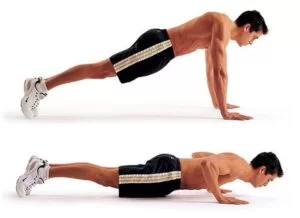
One of the most effective bodyweight workouts for strengthening your triceps and chest is the push-up. However, it also works out your lower back, shoulders, core, and lower body.
Steps To Follow:
- With your hands slightly wider than your shoulders, lay facedown on the floor.
- Raise your chest, knees, and shoulders by pushing up until your arms are fully extended.
- You should only be contacting the floor with your hands and toes.
- Repeat after lowering your body gradually until your chest nearly touches the floor.
Burpee
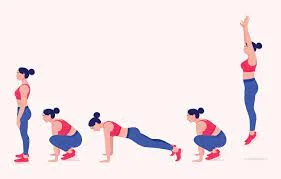
In need of a more forceful workout? Burpees: a full-body aerobic workout that works your arms, back, legs, glutes, and chest. They may be the ultimate bodyweight exercise mash-up.
Steps To Follow:
- Starting from a standing position, crouch down and place both hands on the floor slightly wider than your feet.
- Return your feet to the plank posture.
- After doing a push-up, go back to the plank position.
- Return to a squat position with your legs, then launch yourself upward with your hands above your head.
- Repeat.
Pull-up
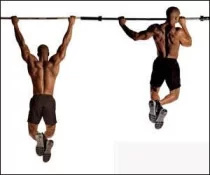
Pull-ups can be scary, particularly if you’re just getting started. However, it’s a fantastic bodyweight workout that targets your biceps, upper back, and shoulders. As you gain strength, gradually increase the number of repetitions you do at first.
Steps To Follow:
- Using an overhand grip, encircle the pull-up bar with your thumbs.
- Start in a dead hang from the bar and play ‘play dead’.
- Using your hands, squeeze the bar while contracting your core and upper body muscles.
- Lift your chin till it clears the bar.
- Reposition yourself such that you are dead-hanging slowly. Repeat.
Plank-up
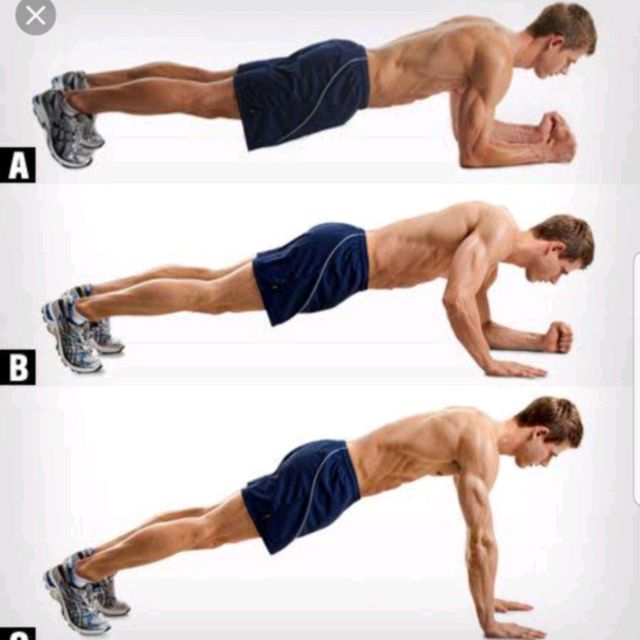
Any kind of plank workout will develop your arms, but plank-ups are particularly good for building the triceps and biceps muscles in your arms.
Steps To Follow:
- Begin in the plank posture, keeping your body raised, elbows and toes on the floor, and your core active.
- One arm at a time, raise yourself into a push-up position while maintaining a straight body.
- Lower yourself onto your elbows
- one arm at a time.
- Repeat.
Triceps dip
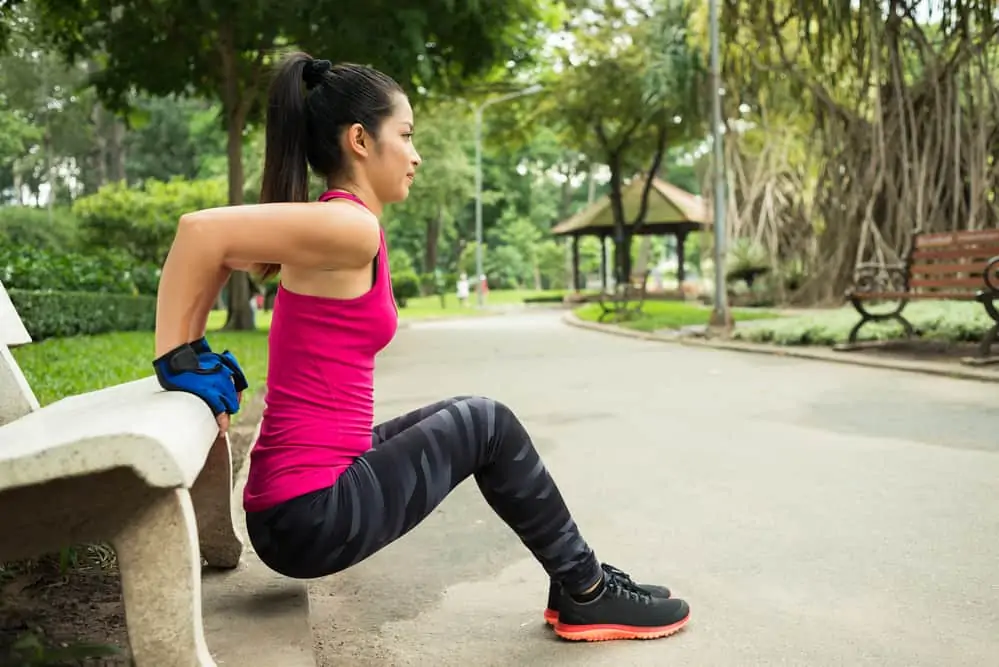
To perform triceps dips, you’ll need a chair, box, ledge, bench, or staircase. Your triceps (and pecs!), which sometimes require a focused workout to grow, will become stronger with regular use of this exercise.
Steps To Follow:
- Sit down in a chair (or on a step, for that matter).
- Using your hands on either side of your hips, grab the chair’s edge.
- Raise yourself up and out past the chair’s edge into a hovering position.
- Legs should be mostly straightened out.
- Once your elbows are nearly parallel to your shoulders, slowly lower yourself towards the floor.
- Raise yourself back up till your arms are straight once more by pressing down into your hands.
- Repeat.
Barbell Back Squat
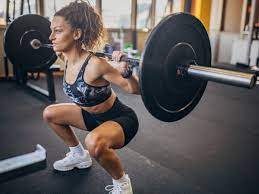
The quadriceps, hamstrings, glutes, and calves are among the main lower-body muscular groups that are worked during a barbell back squat.
It is a basic exercise that is frequently used in strength training regimens to develop power and strength.
Steps To Follow:
- Inhale deeply and tighten your core.
- Hinging at the hips and pushing them back and down is how you start a squat.
- Throughout the exercise, keep your chest up and your back straight.
- As low as you can comfortably go, lower your body till your thighs are parallel to the floor.
- To get back to the beginning posture, stretch your hips and knees while applying pressure through your heels.
- Breathe out as you rise.
- For the specified number of times, repeat the fall and ascent.
Chin-up
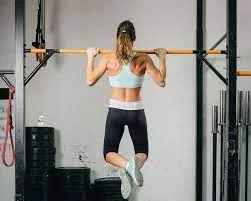
A chin-up is a complex exercise that works the latissimus dorsi, brachialis, and brachii biceps. Additionally, it works the core, rhomboids, anterior deltoids, and trapezius muscles. Chin-ups are a great workout to increase muscular mass and strength in the upper body.
Steps To Follow:
- If a full chin-up is out of your reach, begin with negatives.
- Grasp the bar with an underhanded hold while standing atop a chair or box.
- With control and slowness, lower yourself.
- You can get help in chin-ups by using a resistance band.
- Put your feet within the band and loop it around the bar.
- The band will ease the activity and offer support.
- It’s critical to prioritize form over momentum.
- Retain your core stiff and refrain from swaying.
- Chin-ups are a difficult workout.
- If at first, you are unable to complete them, don’t give up.
- If you practice consistently, you will ultimately gain strength.
Inchworm
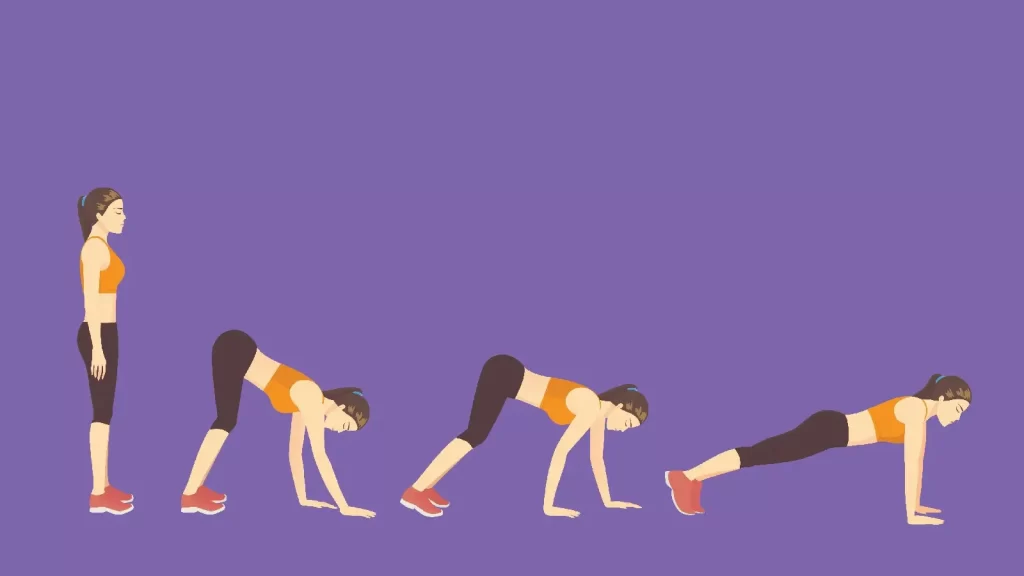
It sounds easy enough, but this bodyweight exercise is almost too easy. This exercise is so eerie that it will make you feel like a kid again while toning your abs, glutes, quadriceps, shoulders, and triceps.
Steps To Follow:
- Knees slightly bowed, stand.
- Reach down and touch your toes slowly while bending at the hips.
- After placing your hands on the ground, “crawl” them away from your body to form a plank position.
- Step forward as if you are an insect until your feet touch your hands.
- Repeat.
Dumbbell Bench Press

A complex exercise that targets your upper body’s pectoralis major (chest), anterior deltoids (shoulders), and triceps brachii (arms) are the main muscles stimulated by the dumbbell bench press.
Steps To Follow:
- Keeping your knees bent and your feet flat on the floor, take a seat on a level bench.
- With your palms facing each other, hold a dumbbell in each hand in a neutral grip.
- Straight up and a little wider than shoulder-width apart, extend your arms.
- Keeping your elbows close to your body, carefully lower the weights towards your chest.
- With a small bend in your elbows, lower the dumbbells until they are slightly over your chest.
- Using your chest muscles, squeeze the dumbbells back up to the starting position.
- Continue till the desired number of times.
Dumbbell Single-Arm Row
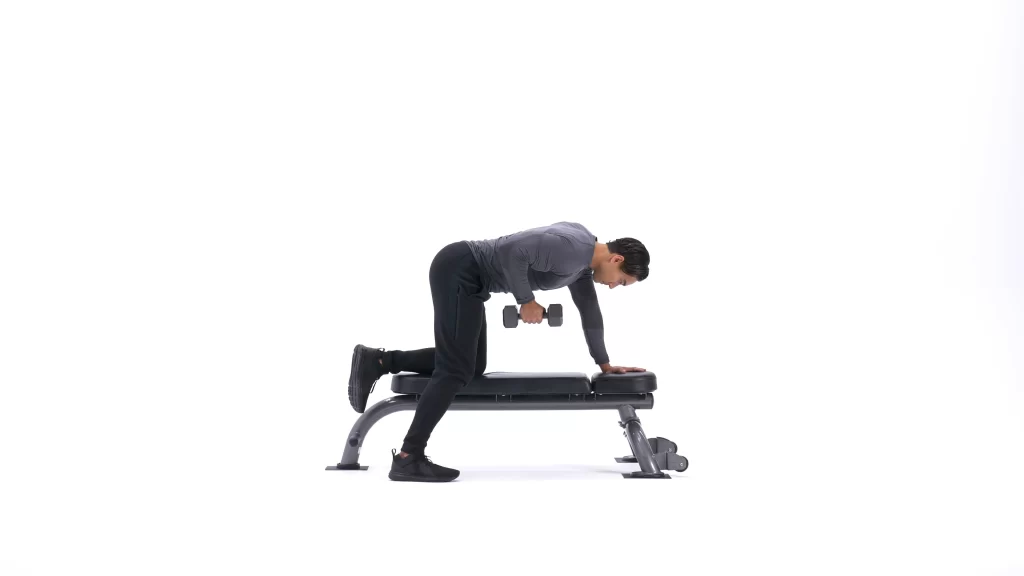
The dumbbell single-arm row is a compound exercise that works a variety of important upper-body muscular groups.
Steps To Follow:
- Next to a level bench or other strong support, set down a dumbbell on the ground.
- With your palm towards the floor, place your hand on the bench just above the dumbbell.
- With your foot level on the ground and your knee straight, extend your opposing leg behind you.
- Lower your body till it is almost parallel to the floor by hingeing at the hips.
- A neutral spine and flat back should be maintained during the exercise.
- Keeping your arm straight, bend down and take hold of the dumbbell with your free hand.
- While bringing the dumbbell closer to your body, raise and lower your elbow.
- At the peak of the exercise, firmly compress your shoulder blades together.
- Controllably return the dumbbell to its initial position.
- Repetition of the required number of Times.
Barbell Straight-Leg Deadlift
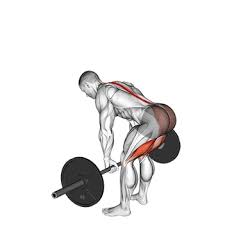
A compound exercise that mainly works the hamstrings, the barbell straight-leg deadlift also works the glutes, lower back, and core muscles to a lesser degree. It is a very powerful workout for developing posterior chain strength and power, which is crucial for both general fitness and sports performance.
Steps To Follow:
- After loading it with the necessary weight, place the barbell on the ground.
- Place your toes slightly outward while standing with your feet shoulder-width apart.
- With your shins nearly touching the bar, take a centering position over the barbell.
- With your hands slightly wider than shoulder-width apart, bend down and grab the barbell with an overhand grip.
- Brace your abdominal muscles and contract your core.
- Maintain a straight back and back and down shoulders.
- Slowly hinge at the hips and descend the barbell towards the floor while maintaining a straight leg position.
- With your back straight and your core firmly engaged, push your hips back and down.
- As low as you can safely go without hurting your back or losing your balance is how low you should lower the bar.
- Pull the barbell back up to the starting position by using your hamstrings and glutes when you’ve reached the bottom of the exercise.
- For full exercise, keep your legs straight and your core active.
- Squeeze your glutes at the peak of the movement as you stand up.
- For the specified number of times, repeat the fall and ascent.
Cable Core Press
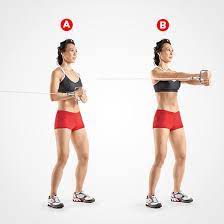
A good core workout that works the rectus abdominis, obliques, and transverse abdominis muscles is the cable core press. It enhances stability and balance, tones and strengthens your core, and helps you stay injury-free.
Several attachments can be used with the cable core press, such as a rope, stirrup handle, or D-handle. Nonetheless, the rope attachment is the most often utilized one.
Steps To Follow:
- Adjust the pulley position on the cable machine to low.
- Connect the cable machine to a rope attachment.
- Using both hands, place them shoulder-width apart and grasp the rope using an overhand grip.
- Place your feet shoulder-width apart and flex your knees just a little.
- Take a small step back and contract your core.
- Press the rope out in front of you while maintaining a strong core, completely extending your arms.
- As you push the rope out, concentrate on contracting your core muscles.
- Don’t use momentum or arch your back.
- Hold for a little moment at the top of the movement.
- While slowly bringing the rope back to its initial position, maintain your core.
- Avoid letting the rope drag you ahead.
- After the required number of repetitions, repeat the exercise.
Dumbbell Farmer’s Walk
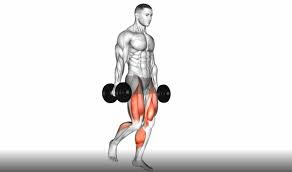
Dumbbell farmer’s walk: a full-body workout that works for several different muscle groups
Steps To Follow:
- Choose dumbbells that will test your strength while letting you walk with the appropriate form.
- Observe proper posture first: Maintain a lofty stance with your feet shoulder-width apart, your core tight, and your shoulders back and down.
- Grab the dumbbells firmly with a neutral grip (palms facing each other), bend down with a straight back, and stand erect without hunching your shoulders.
- Maintain proper posture and activate your core while you walk at a steady pace. Steer clear of swinging the dumbbells or twisting your torso.
- Walk for how long or far you want to: Aim for a fixed length of 30 to 60 seconds or a distance of 20 to 50 meters.
- Take a break and try again: After a little break, continue walking for the required number of times.
Barbell Bench Press
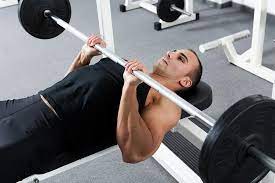
One of the main exercises in any strength training program is the barbell bench press, which focuses on the pectoralis major (chest) muscles and also activates the anterior deltoids (shoulders) and triceps brachii (arms). It is well known for increasing upper body size and strength, which makes it a favorite exercise for gym goers looking to develop a muscular chest.
Steps To Follow:
- With your feet flat on the ground and your knees bent 90 degrees, lie flat on the bench.
- Using an overhand grip with your thumbs wrapped around the bar, hold the barbell slightly wider than shoulder-width apart.
- Squeeze your shoulder blades back together and slightly arch your lower back to provide stability.
- Place the bar so that it is exactly over your chest and in line with your nipples.
- As you gradually and deliberately inhale, bring the bar down to your chest.
- Maintain a 45-degree angle with your elbows tucked in tight to your body.
- The bar should come down to rest just below your nipple line on your chest.
- Take a sharp breath out, stretch your elbows, and press the bar straight back up to the beginning position.
- Keep your lower back slightly arched and your core active.
- Pressing the bar should be done primarily with your chest muscles, not your arms.
- Towards the peak of the exercise, lock your elbows out.
- After the desired number of repetitions, lower the bar back to your chest and repeat the movement.
Trap Bar Deadlift
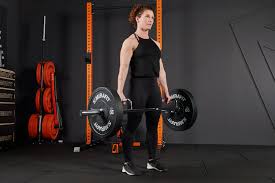
Typically, trap bars feature two sets of handles: low handles, which are at the same level as the rest of the bar, and high handles, which are raised. A trap bar can be deadlifted by grabbing one of the sets of handles while standing inside the bar and lifting it.
Steps To Follow:
- With your toes pointing slightly outward and your feet shoulder-width apart, take a position inside the trap bar.
- With your hands shoulder-width apart, stoop down and grasp the handles with an overhand grip.
- Pull your shoulders down and in and engage your core.
- Keep your lower back slightly arched and your spine neutral.
- Look straight ahead and maintain your head in alignment with your spine.
- Taking a breath, drive your hips down and back while bending your knees slightly.
- To raise the bar, simultaneously extend your hips and knees and apply pressure via your heels.
- Throughout the exercise, maintain the bar’s proximity to your body.
- To stand upright, completely extend your hips and knees when the bar passes over them.
- To keep your posture steady, tighten your glutes and contract your core.
- Keep your lower back from rounding.
- Breathe out and take a slow, backward step to return the bar to its initial position.
- Throughout the descent, keep your spine neutral and your core active.
- Take a brief break after the bar strikes the ground before attempting another repetition.
Legs
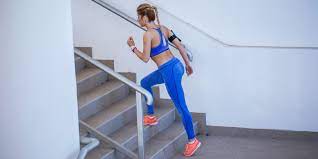
Have a set of stairs? or a container? You can then exercise your legs. Step-ups are an easy starter workout that can help strengthen your hamstrings, quadriceps, and glutes.
Just do one thing at a time.
Steps To Follow:
- Head for your home’s steps, or in the absence of a staircase, set a sturdy box in front of you.
- Put your right foot on the box or the first step, then your left.
- In reverse, take a right footstep and then a left.
- Repeat, each time using a different leg to begin with.
Lunges
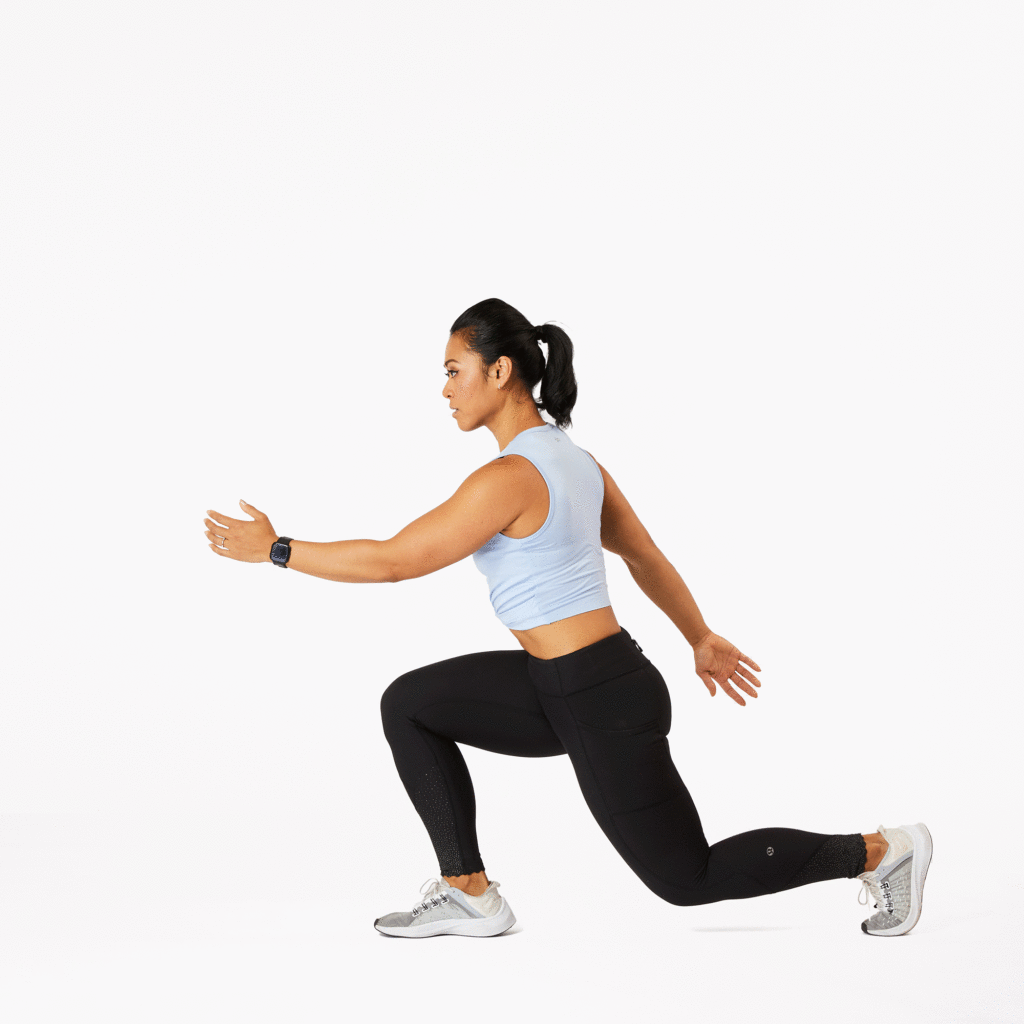
Though there are countless ways to perform a lunge, the basic lunge strengthens your glutes and quadriceps. It also tones your hamstrings.
Steps To Follow:
- Take a large stride forward with one leg while standing.
- When the rear knee is slightly above the floor and the upper thigh of the front leg is almost parallel to it, lower your body towards the ground.
- Apply pressure on your front leg’s heel to raise yourself up.
- Take that large first step again, but with the opposite leg.
Squat

Weightlifters are known for their love of squats, which may give rise to the misconception that they can only be performed with weights. However, if you perform bodyweight squats correctly, you can develop strong leg muscles even with this simple exercise.
Steps To Follow:
- Place your feet just a little wider than your shoulders.
- Put down your palms and extend your arms straight.
- Breathe in, bending at the knees, and push your hips back gently.
- Maintain a straight back, shoulders squared, and chin up while gazing directly ahead.
- Try to squat as low as you can without becoming uncomfortable, putting your hips beneath your knees.
- To thrust forward explosively from your heels, engage your core.
Chest press
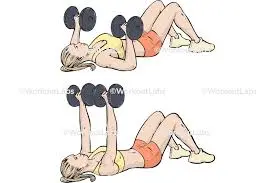
The pectorals and triceps are the main muscles targeted by the chest press, along with your shoulders and triceps. Chest presses are commonly performed in a gym setting using a barbell, but they can also be performed at home with dumbbells.
Steps To Follow:
- Keep your knees bent and your feet flat on the ground.
- lie faceup on a bench or the ground.
- Press the dumbbells straight up while maintaining a brace on your core and holding them at the sides of your chest.
- After that, slowly drop the dumbbells before repeating.
Lying dumbbell fly
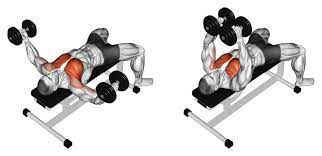
Dumbbell flies are a great way to increase your chest strength. You can perform them on a bench or while lying on the floor. This technique will hammer your deltoids, biceps, and pectorals.
Steps To Follow:
- Bend your knees and lie down on a floor or bench.
- With the palms of your hands facing each other, hold the dumbbells straight above your chest.
- Bend your elbows to the point of comfort (or, if you’re not using a bench until they touch the floor) while you slowly lower the dumbbells to your sides.
- Raise the dumbbells back above your chest while bending your elbows, then repeat.
Pullover
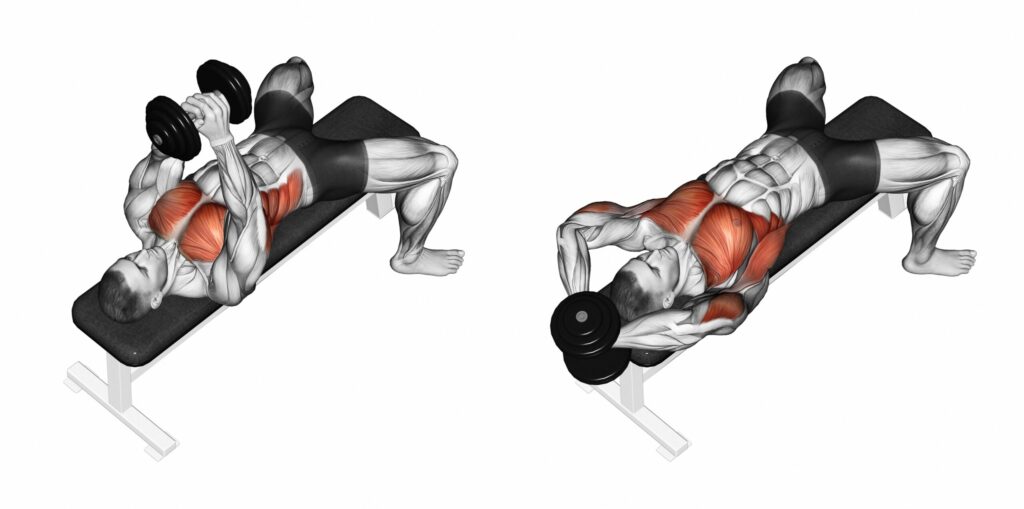
Like a lumberjack cutting wood, build up your lats, pecs, and abs (without worrying about an axe or your aim). You can perform this dumbbell workout on a floor, bench, or stability ball. Just make sure you hold onto the dumbbell firmly!
Steps To Follow:
- Feet flat on the ground, lie face up.
- Raise a single dumbbell above your chest while holding it in both hands.
- Bending your elbows slightly, slowly extend the dumbbell overhead and then return it to its original position. Make sure you begin this one with a weight that is manageable for you.
- Take no chance and avoid landing the dumbbell on your head or chest!
Biceps curl
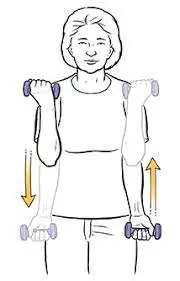
This time-tested biceps workout increases arm strength and develops the muscles you want to show off in the mirror.
Steps To Follow:
- Dumbbells should be held at your sides, straight, whether you are sitting or standing.
- As you rotate your arms so that your palms are facing your shoulders, bend your elbows and raise the weights up towards your shoulders.
- Restart at the beginning position slowly, then do it again.
Triceps extension

With this triceps-building workout, which calls for some good technique and focus, you’ll raise your arms in triumph. This is a standing or sitting exercise.
Steps To Follow:
- Hold a dumbbell in both hands while standing with your feet hip-width apart.
- With your arms straight, raise the weight overhead.
- Then, bend your elbows and bring the weight down behind your head.
- Repeat after raising the weight back above your head.
- For best results, maintain as much stability and stillness in your upper arms as you can.
Wrist curl
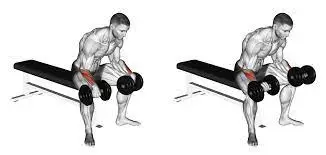
This exercise strengthens your forearm muscles in addition to your hand strength. This frequently disregarded muscle group is utilized for a variety of tasks, such as manipulating a computer mouse and twisting knobs.
Steps To Follow:
- With a small dumbbell in each hand, take a seat on a bench or chair.
- With your hands stretched past your knees and your wrists on top of your knees, place your forearms on your thighs.
- You are able to raise or lower your palms.
- Curl the weights slowly upward and then downward.
- Don’t move your arms; simply move your hands.
- Repeat.
Details, Guidelines, and Clarifications
It’s time to address any queries you might have, dispel any doubts you might have, and walk you through how to get the most out of everything.
The Muscle Building Workout Routine’s general rules
- You should use the same weight for every set of exercises. In other words, you would use the same weight for all three sets of an exercise if it called for doing so. As an illustration…
100 lbs, 100 lbs, 100 lbs is the proper way. - Incorrect Way: 95, 100, and 105 pounds.
- The next time you perform that exercise, you should raise the weight by the lowest amount once you can lift a certain weight for the number of sets and repetitions that are specified. The next step would be to repeat this progression as frequently as possible. (I’ll go into much more depth about this in a moment.)
- Warm-up sets are not included in the stated number of sets. Only those are the real work sets. As necessary, warm up.
- The exercises should be completed in the sequence stated, which corresponds to their intended order. Keep it the same.
- Every exercise on the schedule is what you should be doing. But if there’s something your gym doesn’t have or something you can’t really do because of an injury you haven’t healed from, or for any other REALLY good reason, go for the next closest match. (I’ll include some recommendations below.)
- The split, frequency, choice of exercises, number of sets, repetitions, and rest periods for each exercise, as well as the overall volume… Everything has a purpose and should be completed EXACTLY as I have described it.
Information and Explanations on Upper Body A
- The Head and Neck Exercise 1 begins with the bench press. This is supposed to be a bench press with a flat bar.
- Having a spotter is advised, if at all possible. Not only is it crucial for obvious safety reasons, but not having one could prevent you from trying for a second rep, which could impede your progress.
- The next exercise is a row, which is essentially a back row exercise or some other kind of horizontal pull. Choose your favorite back row; pretty much any kind would work well here.
- If I had to recommend a rowing exercise, I might propose something along the lines of a chest-supported row, as this type of rowing doesn’t really require lower back stabilization.
- The way a bent-over barbell row would. Furthermore, for those of you who will be deadlifting the next day, this might be a wise decision.
- If not, feel free to choose whatever kind of horizontal back row you like, such as a bent-over barbell or dumbbell row, a t-bar row, a supported-by-the-chest row, or any other Hammer Strength machine row if your gym offers them.
- It’s okay as long as there’s some kind of back row. Stick with something chest-supported to give your lower backrest the day before performing deadlifts if you think it will help. Choose anything else if not.
Incline dumbbell presses for incline pressing
- In theory, this may be done with any kind of incline press. Dumbbells, barbells, and machines (I adore Hammer Strength’s incline chest press).
- However, I would unquestionably suggest the incline dumbbell press as my first option (in which case, be sure to set the bench to a 30-degree slope or slightly less, not higher).
lat pull downs
- I advise utilizing an underhand grip (palms facing you) or a neutral grip (palms facing each other) for lat pulldowns because they are considerably easier on your elbows and wrists.
- This is because, for the Upper Body B workout, I will be recommending an overhand hold (palms facing away from you). You’ll discover. You should always perform these exercises in front of your head rather than behind it.
laterals raise
- You are essentially free to perform any type of lateral rise you like. With cables, dumbbells (either seated or standing, one arm at a time, or both at once), and, if your gym has a good one, a lateral raise machine. Simply select your favorite.
Triceps exercise
- I suggest doing cable press-downs with pretty much any kind of handle that you find most comfortable. Personally, I like the rope or V-bar more.
Biceps exercise
- I suggest doing any kind of dumbbell curl for your biceps exercise today—you can do it while standing, sitting, on a preacher bench, or anything else. Select your preferred option.
Details and clarifications for Lower Body A
Romanian deadlift
- The Lower Limb Start a workout with a Romanian deadlift. Instead of employing a mixed grip (one hand over, one under), I advise using a double overhand grip.
Leg presses
- You can perform the leg presses with both legs at the same time, as is customary, or with just one leg if it is feasible. It’s also intended to be performed in a 45-degree leg press. Use the leg press that your gym does have if it doesn’t have one.
Leg curls
- Certain gyms feature leg curl machines that may be used in three distinct ways: sitting, standing, and lying down. Actually, you can choose anybody you choose.
Standing calf raises
- Standing calf lifts come next. If there isn’t a standing calf raise machine at your gym, you can still perform 45-degree leg presses for your calves.
For ABS
- Do as many sets as you like for your abs. Just don’t go overboard—no more than ten minutes, please. Simple exercises like planks, hanging leg lifts, and weighted crunches are things I enjoy doing. Don’t complicate things.
Details and clarifications for Upper Body B
- To begin the Upper Body B workout, perform pull-ups. Make use of an overhand grip. If pull-ups are out of your reach, try lat pull-downs or an aided pull-up that still requires an overhand grasp. It’s alright. But you should really work towards being able to perform pull-ups here and make that your ultimate objective. You still need to perform these exercises in front of your head, never behind your neck. You should also add weight if you can already perform three sets of six to eight pull-ups. Look for a “pull-up belt” (also known as a “dip belt”) online and purchase one. It will let you increase the weight when performing bodyweight exercises like dips and pull-ups. Progressive overload requires using it when using your own body weight gets too simple. It’s one of the few training devices I wholeheartedly suggest.
- I suggested performing seated dumbbell presses or barbell presses (in front of you, not behind your neck) for the shoulder press, however, any type of overhead press should work just well.
- Seated cable rows are the next exercise, and for best results, use a parallel/neutral grip (palms facing each other). Any alternative grip will do if the handle at your gym isn’t like that. Feel free to substitute any other comparable horizontal back row for the sitting cable row if your gym does not offer one for any reason.
- The flat dumbbell bench press is the following exercise. Not much more can be said about this.
- The next exercise is dumbbell flies. Although they are designed to be performed on a level or slightly inclined bench, you are welcome to substitute a cable fly or a pec deck machine if you would prefer.
- I suggest using an EZ curl bar for standing barbell curls as an exercise for your biceps because it will be much easier on your wrists and elbows. Of course, you could substitute any other kind of curl if you’d like.
- I suggest using skull crushers as an exercise for your triceps. For the same reason that an EZ curl bar is considerably softer on the wrists and elbows than a straight bar, I suggest using one of these or dumbbells with your palms facing each other when performing these exercises. Either a flat or decline bench can be used for these. Both are perfectly acceptable. Furthermore, any comparable triceps isolation workout would be a fantastic substitute if desired.
Details and clarifications for Lower Body B
squats
- Start the Lower Body B exercise program with squats.
split squats
- You can use dumbbells or a barbell for the split squats. I would suggest starting with dumbbells rather than a barbell if you have never performed any sort of split squat or lunge variation previously. It will be simpler and safer to develop good self-balancing skills.
leg curls
- If your gym truly has more than one sort of leg curl machine, I would suggest utilizing a different kind for the leg curls than you did for the Lower Body A program. Use both legs together in this workout and one leg at a time in the A workout if your gym only offers one type. Or, hyperextensions would also work in this situation if desired.
- Seated calf lifts come next. Not much more can be said about this.
For abs
- Do as many sets as you like for your abs. Just don’t go overboard—no more than ten minutes, please. Simple exercises like planks, hanging leg lifts, and weighted crunches are things I enjoy doing. Make it easy.
A Muscle Building Diet Plan Is Required
- This still only makes up half of the equation for gaining muscle, no matter how well thought out your weight training regimen is (and The Muscle Gaining Workout Routine is pretty damn well developed), or how flawlessly you carry it out.
- Your diet makes up the other half.
- To help you achieve your aim of gaining muscle, you MUST eat healthily. Should you fail to do so, this program—as well as all other programs—will consistently malfunction.
Conclusion
Though simple, gaining muscle is difficult. At least twice a week, work every muscle group, pushing your workouts to the limit. Make sure you eat a diet high in protein, healthy fats, and complex carbohydrates, and get enough sleep so that your muscles can repair and grow. Even though it may take months to gain appreciable bulk, you ought to start noticing and experiencing changes far sooner.
FAQs
Which exercise regimen is ideal for building muscle?
Because all connected muscle groups are exercised simultaneously during a single workout, the push/pull/legs split is perhaps the most effective split available. This indicates that you obtain the most movement overlap possible during a single session, which benefits the targeted muscle groups in general.
How can I work out to put on muscle?
Among the best workouts are deadlifts: One type of compound exercise that targets the posterior chain muscles is the deadlift.
Squats: Squats work a variety of muscles.
Bench Press: One of the most traditional upper body exercises is the bench press.
Exercise for the dominant shoulder is the overhead press.
Can you gain muscle with 10 kg dumbbells?
Is 10 kg Dumbbell Sufficient For Building Muscle? – Complete Body Guide
For many gym-goers, gaining muscle is a primary priority. Because there is a lot of misleading information online about this subject, we are here to dig deep and provide a definitive answer. To put it briefly, the answer is yes: 10 kg dumbbells will do the job of building muscle.
What is the daily dumbbell count?
Finish one set.
Select a weight that, after 12–15 repetitions, causes your muscles to get fatigued. One set of that could have the same muscle-building effects as three sets combined.
Why am I not gaining more muscle?
You don’t consume enough protein. Eating extra protein will help you gain greater muscle mass. The building block of your muscles is protein. According to recommendations, you should consume one gram of protein for every pound of body weight.
Reference
- Muscle Building. (n.d.). Muscle & Strength. https://www.muscleandstrength.com/workouts/muscle-building
- J. (2022, December 17). The Muscle Building Workout Routine. A Workout Routine. https://www.aworkoutroutine.com/the-muscle-building-workout-routine/
- The Best Gym Workout Plan For Gaining Muscle | PureGym. (n.d.). PureGym. https://www.puregym.com/blog/the-best-gym-workout-plan-for-gaining-muscle/
- Curley, B. (2020, December 18). Gym Rat No More: 18 At-Home Exercises to Build Muscle. Greatist. https://greatist.com/fitness/exercises-at-home-to-build-muscle#build-muscle-without-weights

